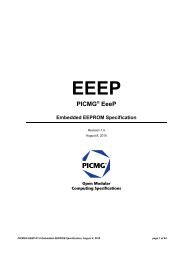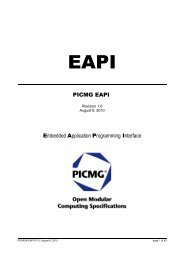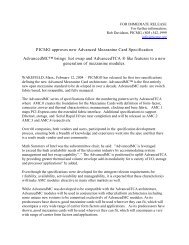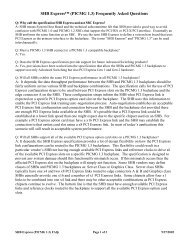PICMG 2.14, CompactPCI Multicomputing
PICMG 2.14, CompactPCI Multicomputing
PICMG 2.14, CompactPCI Multicomputing
Create successful ePaper yourself
Turn your PDF publications into a flip-book with our unique Google optimized e-Paper software.
INTRODUCTION<br />
FOR INFORMATION ONLY;<br />
DO NOT ATTEMPT TO DESIGN FROM THIS DOCUMENT<br />
This short form specification is a subset of the full <strong>CompactPCI</strong> MultiComputing specification, Revision<br />
1.0 as approved by <strong>PICMG</strong>. This document is meant as a guide for those considering <strong>CompactPCI</strong><br />
MultiComputing applications, but is not a design document. Anyone intending to design a system<br />
employing <strong>CompactPCI</strong> MultiComputing should obtain the full specification from <strong>PICMG</strong>.<br />
<strong>CompactPCI</strong> is an open specification family supported by <strong>PICMG</strong>, a consortium of companies involved<br />
in open architecture computing for demanding applications. <strong>PICMG</strong> develops, administers and maintains<br />
the specifications in this family.<br />
Objectives<br />
The <strong>CompactPCI</strong> MultiComputing Network (MCNet) allows multiple Peripheral Nodes (PN) CPU<br />
boards and one System Node (SN) CPU board to perform inter-processor communications (IPC)<br />
over a <strong>CompactPCI</strong> backplane (or other shared PCI address space) as if they were discrete computers<br />
on a network. The software interface to perform IPC may be the protocol stack packaged with the<br />
operating system using the MCNet as a data link layer, or there may be a direct application<br />
programming interface (API) to the MCNet data link layer driver, bypassing the OS network<br />
protocol stack. The interface to the data link layer is not fully specified, allowing implementers to<br />
choose an interface suited to their application requirements.<br />
An MCNet comprises one System Node and zero to N Peripheral Nodes. An MCNet operates within<br />
1 to M PCI bus segments that are logically one PCI address space. The design will accommodate<br />
over 4,000 PNs per MCNet. An MCDevice may have a PN on one MCNet and an SN or PN on<br />
another, thereby facilitating packet routing between two or more distinct PCI busses.<br />
All System and Peripheral Node service sharing is a function of the operating system’s ability to<br />
provide shared network services via the protocol stacks (e.g. Windows file and print sharing<br />
capabilities, NFS, etc). The MCNet protocol specification accommodates Hot Swap and other fault<br />
management of MCNodes and MCDevices.<br />
Packet buffering is performed in a non-contentious manner, thereby not requiring read-modify-write<br />
locked cycles.<br />
Purpose<br />
Define packet-based communications between heterogeneous PCI agents (MultiComputing) within<br />
the <strong>CompactPCI</strong> system architecture.<br />
Users of <strong>CompactPCI</strong> have expressed interest in seeing standardization in the methods for processor<br />
boards to communicate with each other when co-existing in a shared PCI address space.<br />
Goals<br />
These are goals whose definition will allow multiple vendors with diverse architectures to<br />
interoperate.<br />
• OSI Data Link Layer network model approach<br />
• Discovery and Initialization of heterogeneous devices following system initialization or Hot<br />
Swap<br />
• Buffer structures<br />
• Messaging<br />
<strong>PICMG</strong> <strong>2.14</strong> R 1.0 <strong>CompactPCI</strong> MultiComputing Short Form Specification, page 2
















